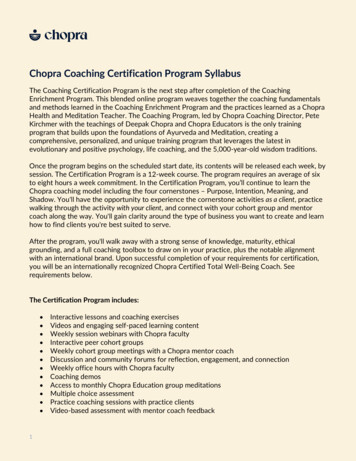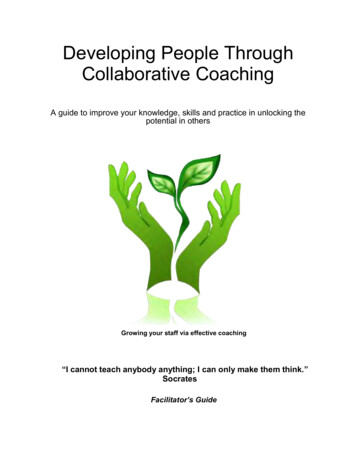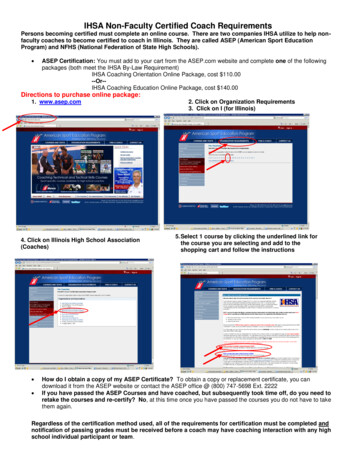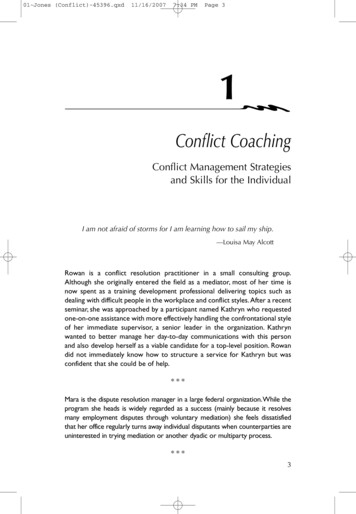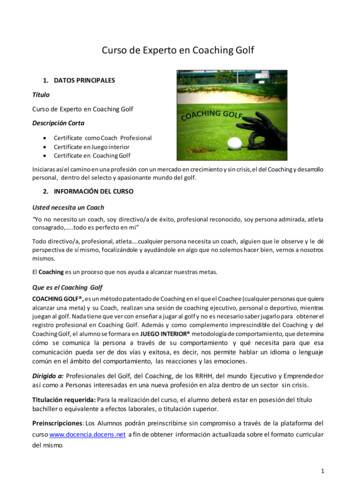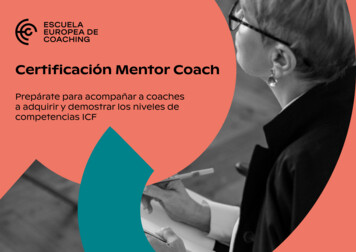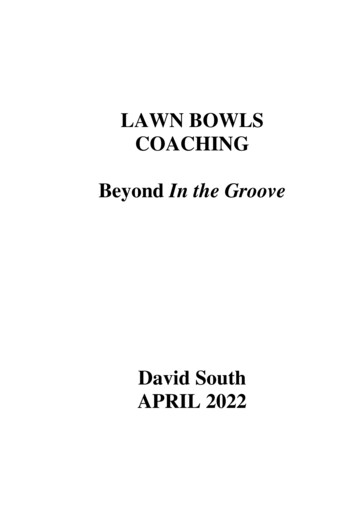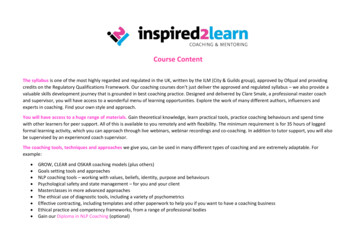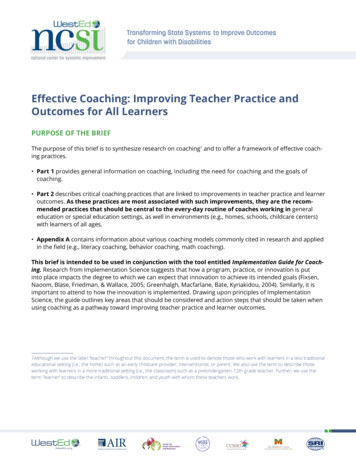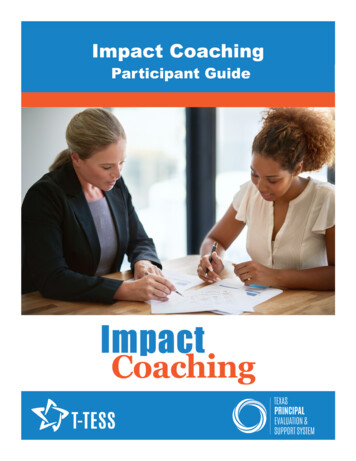
Transcription
Impact CoachingParticipant Guide
Table of ContentsOutcomes/ Norms .3Robert Quinn: Deep Change. 4Why Coaching as a Model & Imagine the Impact . 5Core Values and Beliefs & Clock Partners . 6Coaching as a Systemic Model . 7Identity Roles . 8Reflection & Impact Coaching Competencies . 9Impact Coaching Self Assessment. 10Limiting Beliefs/ Telling Stories & Active Listening . 13Listening Set-Asides & Paraphrasing and Summarizing . 14Paraphrase Practice & Levels of Emotions and Coaching . 15Powerful Questions & Layers of Questions . 16Pre-suppositions . 17T-TESS Domains and Dimensions 18Sample Questions . 23Questions When Stuck & Coaching Maps. 26Planning Conversations . 27Planning Map Application & Coaching and Conferences . 28Day 1 Reflection . 29CSI: Color, Symbol, Image . 30Reframing and Shifting . 31Reflective Conversations . 33High Leverage Practices . 34Action Coaching. 35Model Case Study . 36Case Study #1: 7th Grade Math . 37Case Study #2: Middle School English . 38Micro-Lab Protocol. 39Personal Coaching Plan . 40Planning Conversation Map (Poster) . 41Reflective Conversation Map (Poster). 42 TEA2/10/2022Impact CoachingParticipant Guide2
ImpactCoaching,600Outcomes To continue integrating the ideals and practices of coaching throughout the “school” community To cultivate a culture of growth, development, support, and coaching that is intentional To individually and collectively align our skills, knowledge, and responsibilities to the role of thecoach To enhance planning, reflecting, problem-solving, and instructional capabilities for self andothers To embed the coaching principles into teaching and learning as an ultimate self-directedprocessNorms Participate whole-heartedly Identify opportunities to connect this work personally and professionally What is said here stays here; what is learned here leaves here Professional use of technology Follow the 80/20 rule Other?Impact Coaching Idea:An instructional coach must be an expert in building relationships, even with thoseteachers who resist change. Providing continuous assistance until the skill has beenlearned, practiced and sustained is essential. A coach 's interaction with a teacheroccurs for short periods of time. Such interaction provides help and assistance basedon information gleaned through assessment and observation where teacher behavioris changed. (Knight, 2007) Texas Education Agency 2/10/20223
Robert Quinn: Deep ChangeSlow DeathWe have a choice; we can change and grow or we can experience slow death, according to RobertQuinn, a professor of business at the University of Michigan. In his book, Deep Change, Quinndiscusses how individuals and organizations can bring about transformational changes that help createexcellence and alter the culture of organizations. This is the essence of deep change.In our world of constant change, we see “slow death” manifest itself. What are some phrases thatcontribute to this phenomenon? “Don’t rock the boat.” “We’ve been here before.” “There’s no need tochange.” “Denial excuses chaos . ”Staying in our comfort zones represents the path of least resistance. Changing is far more difficult.Leadership comes from influence. We’ve all heard the phrase, “you’re not leading if no one isfollowing.”One key to successful leadership is continuous personal change. Personal change is a reflection of ourinner growth and empowerment. Empowered leaders are the only ones who can induce realchange. They can forcefully communicate beyond a level beyond telling. By having the courage tochange themselves, they model the behavior they are asking of others.The hero’s journey is a story of individual transformation, a change of identity. In embarking on thisjourney, we must leave the world of certainty. We must courageously travel to a strange place wherethere are lots of risks and much is at stake, a place where there are new problems that require us tothink in new ways. TEA2/10/2022Impact CoachingParticipant Guide4
Why Coaching as a Model for Growth and Development?The Role of the Coach Imagine the ImpactGet Better Faster – Paul Bambrick-Santoyo The purpose of instructional leadership is not to evaluate teachers, but to develop them. Great instructional leadership isn’t about discovering master teachers ready-formed. It’s aboutcoaching new teachers until the masters emerge. You can’t make practice perfect until you define what perfect looks like. Practice doesn’t make perfect, but perfect practice does. Contenders practice until they get it right. Champions practice until they cannot get it wrong.Golden CircleWhat– Simon SinekHowWhy TEA2/10/2022Impact CoachingParticipant Guide5
ReflectiveActionCoachingCoachingInvolves using multiple levels of inquiry orquestioning to promote self-directed behaviors.Involves providing specific performance actionsfor direct and consistent impact.Core Values and Beliefs Given your leadership role, what are your core values and beliefs about developing andsupporting others? Consequential Actions: As a result of my beliefs, this is what I do to develop and supportothers Clock Partners3:00 Partner6:00 Partner9:00 Partner12:00 Partner TEA2/10/2022Impact CoachingParticipant Guide6
Impact Coaching Idea:Instructional coaches follow a routine protocol when working with teachers observation, preconference, demonstration, and reflection/post-conference. This continuous cycle affords theteacher time to observe demonstrations and practice the new skills. In addition, the coach andteacher engage in reflective discussions and plan action steps for growth and change. It is apartnership based on trust. (Knight, 2007)Coaching as a Systemic Model District CampusesWhy?Why?Why?Why? Teachers StudentsWhy is a deeply rooted, intertwined district level systemic approach to coaching necessaryto ensure the success and sustainability of staff growth and effectiveness?Are you the bamboo, the redwood, or both? Why? TEA2/10/2022Impact CoachingParticipant Guide7
Identity RolesRole IdentityOrientationCommunicates Language/ResponseParentProtector, Guardian,Fosters Dependency: Iwant you to besuccessful andinvested in my values.I am wise andexperienced. This is adependency relationshipwith reciprocated caring.“I have lots of experience organizingfield trips, so let me take care of theplans for you.”Instructor, Specialist:Transmits expertise. Iwant you to developcorrect andappropriateperformance.There is a certain way todo things. Expertise ishierarchical. Authority isrelated to knowledgeand skill.“You need to see this museum andvisit exhibits 1-5, because they arethe most important ones needed toteach that concept.”Advisor, Confidant:I want us to developand maintaincompanionship andfriendship.We have a relationship.The relationship is ofprimary value and mustbe protected.“I would love to go along with you onthe field trip – I would enjoy sharingthe experience.”Authority Figure:I expect compliance. Iam responsible forsuccess or failure.I am responsible. Powercomes from position. Iam required to direct,control, and own finalresponsibility.“Since I need to be sure you knowhow to take responsibility foreveryone’s safety and since there aremany issues to consider, let’s set atime to discuss it. I’ll make the finaldecision about the time and place foryou.”Co-Learner: We havean interdependentrelationship in whichyou support mylearning, and I yours.Resources are internal.Each of us has thecapacity to self-mediateand self-modify. Thereare many ways to dothis.“As you think about the learningoutcomes you have identified for thefield trip, what possible sites couldyou visit to accomplish these ssResponse:CoachResponse:Source: Modified from Cognitive Coaching TEA2/10/2022Impact CoachingParticipant Guide8
Reflection What are the potential results if we stay in the first four identities? Which role do you gravitate toward? Why? How do others see you? What is the impact on the relationship and performance when we assume the role of the“coach”?Impact Coaching Competencies(Adapted from International Coach Federation Core Competencies www.CoachFederation.org)Begin with the end in mind TEAMutual Respect, Trust,Rapport andRelationshipsActive ListeningParaphrasing andSummarizingPowerful QuestionsCoaching PresenceReframing andShiftingCreating Awarenessand ConsciousnessActions and OutcomesProgress, Impact, andAccountability2/10/2022Impact CoachingParticipant Guide9
Impact Coaching Self- Assessment1. Mutual Respect, Trust,Rapport, RelationshipsThis coaching competencyincludes the ability to create anenvironment that is safe,supportive, and reflective ofMutual Respect, Trust,Rapport, and Relationships.As a coach, I: Show genuine concern for the coachee’s well-being, includingcurrent and future practices. Demonstrate respect at all times. Am “in check” with what my nonverbal behaviors communicate. Continuously demonstrate personal integrity, honesty and sincerity insupporting growth. Establishes clear agreements and keep promises. Demonstrate respect for the coachee’s perceptions, learning style,and personal being. Establish and maintain trust and am trustworthy. Set aside judgment. Provide ongoing support for and champion new behaviors andactions, including those involving risk taking and fear of failure, as ameans of refining each coachee’s skills, knowledge andresponsibilities.2. Active ListeningThis coaching competencyincludes making a consciouseffort to hear not only thewords that another person issaying but, more importantly,try to understand the completemessage being sent.As a coach, I: Look at the coachee/speaker directly. Put aside distracting thoughts. Avoid being distracted by environmental factors and sideconversations. "Listen" to the coachee’s body language. Organize the thoughts as I listen. Attend to the coachee and the coachee’s agenda and not to myagenda for the coachee. Hear the coachee’s concerns, goals, values and beliefs about what isand is not possible. Distinguish between the words, the tone of voice, and the bodylanguage. Summarize, paraphrase, reiterate, and mirror back what the coacheehas said to ensure clarity and understanding. Encourage, accept, explore and reinforce the coachee’s expressionof feelings, perceptions, concerns, beliefs, suggestions, etc. Integrate and build on the coachee’s ideas and suggestions. Understand the essence of the coachee’s communication and helpthe coachee get there rather than engaging in long, descriptivestories. Allow the coachee to vent or "clear" the situation without judgment orattachment in order to move on to next steps.3. Paraphrasing andSummarizingThis coaching competencyincludes the ability to clarifyand gain insight about theemotion and meaning behindwhat was stated and rephraseit back to the speaker.As a coach, I: Attend fully. Listen with the intent to understand. Capture the essence of the message. Reflect the essence of voice, tone, and gestures. Paraphrase before asking a question. Address the emotions before content when emotions are present. Understand and apply the three types of paraphrasing. TEA2/10/2022Impact CoachingParticipant Guide10
4. Powerful QuestionsThis coaching competency focuseson how the supervisor crafts andasks questions that facilitatethinking, reflection, and action.As a coach, I:5. Coaching PresenceAbility to be fully conscious andcreate a spontaneous relationshipwith the coachee, employing astyle that is open, flexible, andconfident.As a coach, I:6. Reframing and ShiftingAbility to facilitate reframing andshifting to help others to seethings differently and, as a result,come to different, moreempowering conclusions orfeelings about the event orexperience.7. Creating Awareness andConsciousnessAbility to integrate and accuratelyevaluate multiple sources ofinformation and to makeinterpretations that help thecoachee to gain awareness, andthereby achieve agreed-uponresults. TEA2/10/2022 Ask open-ended questions that create greater clarity, possibility or newlearning. Ensure the questions are non-judgmental. Understand and am cognizant about presuppositions. Ability to ask questions that reveal the information needed for maximumbenefit to the coaching relationship, coachee, and students. Ask questions that reflect active listening and an understanding of thecoachee’s perspective. Ask questions that evoke discovery, insight, commitment or action (e.g.,those that challenge the coachee’s assumptions). Ask questions that move coachees toward what they desire, not questionsthat ask for the coachee to justify or look backward. Ask questions that focus on refining practices at higher performance levelsof the T-TESS/T-PESS Rubric. Am present and flexible during the coaching process.Access my own intuition and trust my inner knowing--"go with the gut."Am open to not knowing and to taking risks.See many ways to work with the coachee and chooses in the moment whatis most effective. Use humor effectively to create lightness and energy. Confidently shift perspectives and experiment with new possibilities forown action. Demonstrate confidence in working with strong emotions and can selfmanage and not be overpowered or enmeshed by the coachee’s emotions.As a coach, I: Reframe or shift a situation for the coachee to provide a new perspectiveand, with it, new possibilities. Reframe and articulate to help the coachee understand from anotherperspective what he/she wants or is uncertain about. Offer and invites more and varied ways for coachees to consider theproblems they are facing and to find new ways to meet the challenges.As a coach, I: Go beyond what is said in assessing the coachee’s concerns, not gettinghooked by the coachee’s description. Invoke inquiry for greater understanding, awareness, and clarity. Identify for the coachee his/her underlying concerns; typical and fixed waysof perceiving himself/herself and the world; differences between the factsand the interpretation; and disparities between thoughts, feelings, andaction. Help coachees to discover for themselves the new thoughts, beliefs,perceptions, emotions, moods, etc. that strengthen their ability to takeaction and achieve what is important to them.Impact CoachingParticipant Guide11
Communicate broader perspectives to coachees and inspire commitmentto shift their viewpoints and find new possibilities for action. Help coachees to see the different, interrelated factors that affect themand their behaviors (e.g., thoughts, emotions, body, and background). Express insights to coachees in ways that are useful and meaningful for thecoachee. Identify major strengths vs. major areas for learning and growth, and whatis most important to address during coaching. Ask the coachee to distinguish between trivial and significant issues andsituational vs. recurring behaviors, when detecting a separation betweenwhat is being stated and what is being done.8. Actions and OutcomesAs a coach, I:This coaching competency Assist in defining and designing actions; engage others in exploring ideasinvolves coaching and supportingand solutions; confront and embrace shortfalls; support others’ selfdiscipline and accountability for outcomes and results; and celebrateothers in taking actions that leadsuccesses and growth.to realizing goals and outcomes. Clearly coach actions that will move the coachee toward his/her stated andagreed-upon goals and outcomes. Demonstrate follow-through by asking the coachee about those actionsthat he/she committed to during the previous conversations. Promote the coachee’s self-discipline and holds him/her accountable foractions, for the results of an intended action, or for a specific plan withrelated time frames. Engage the coachee to explore alternative ideas and solutions, to evaluateoptions, and to make related decisions. Celebrate the coachee’s successes and capabilities for future growth.As a coach, I:9. Progress, Impact, andAccountability Clearly request additional actions that will move the coachee towardThis coaching competencyhis/her stated goals.includes the ability to hold Demonstrate follow-through by asking the coachee about those actionsattention on what is important forthat the coachee previously committed to, including data and evidence tothe coachee, and to leaveshow progress and impact.responsibility with the coachee to Focus on the plan of action, but am also open to adjusting behaviors andtake action.actions based on the coaching process and shifts in direction duringsessions. Promote the coachee’s self-discipline while establishing accountability foractions, timelines, results, and impact or subsequent actions. Positively confront the coachee with the fact that he/she did not takeagreed-upon actions and determine next steps.Adapted from International Coach Federation Core Competencies www.CoachFederation.org TEA2/10/2022Impact CoachingParticipant Guide12
Limiting BeliefsTelling StoriesLimiting beliefs are the thoughts andfeelings that constrain, limit or inhibitsomeone from moving forward. Theypresuppose that limitations exist and areoften rooted in prior experiences. Thesebeliefs may be about self and/or others.Examples:You see and hear something, and then you tellyourself a story. That story triggers yourfeelings. Then you either act on those feelingsor have them act on you.Implications for the Coach:Implications for the Coach:Implications for the Coachee:Implications for the Coachee:Examples:Active ListeningImproving listening skills requires practice with "active listening." This is where you make a consciouseffort to hear not only the words that another person is saying but, more importantly, try to understandthe complete message being sent.“Effective listening involves three strategies:1. Committing to respectfully hearing what others have to say.2. Letting others be the focus of the conversation at least for some of the conversation, and3. Pausing before we respond to any comment to consider whether what we are about to saywill open up conversation or shut it down.”- Dr. Jim Knight TEA2/10/2022Impact CoachingParticipant Guide13
Listening Set-Asides Autobiographical Solution InquisitiveCredibleVoiceApproachableVoiceCredible VoiceApproachable VoiceParaphrasing and SummarizingParaphrases fall into one of three logical levels of responses:1. Acknowledge and Clarify: Provides opportunities to validate and calibrate ourunderstanding of emotions and the content presented in the conversation.2. Summarize and Organize: Includes taking the content presented in the conversation andsummarizing/organizing it into themes and containers.3. Ladder of Abstraction (shift the focus to higher or lower logical level): For global thinkers,shifting the logical level down grounds their thinking in specific examples and details. Forthose who think in highly sequential and concrete patterns, the shift up to a higher levelhelps them to explore the bigger picture and provides a broader context for thinking andproblem solving. This paraphrase allows the speaker/teacher to flex their style. TEA2/10/2022Impact CoachingParticipant Guide14
Acknowledge and ClarifySummarize and OrganizeLadder of AbstractionLevels of Emotions and CoachingEmotions before content when emotions are present!All emotions use the body as their “theatre,” but emotions also affect numerous brain functions. In atypical emotion, regions of the brain send commands to other regions of the brain and to almostevery area of the body through chemical and neural responses. Emotions may be expressedverbally or through other physical changes. Voice, posture, breathing, gestures, muscular tone, skintone, and color are among some of these changes. While the coach may not know the meaning ofeach behavioral change, this information does signal that a change has occurred. Emotions bothregulate and represent body states. The coach is attentive to emotional language and physicalchanges that signify emotions are present.“Your brain can be compared to an automatic transmission. When the going gets tough (e.g.,situations of trauma, crisis, or any type of fear) your brain automatically downshifts to help you getthrough. In situations of trauma, crisis, or any type of fear, the brain downshifts in an attempt toaccess functions that promote safety.” We often refer to this as the “fight or flight” theory.The Triune Brain helps us understand how thoughts and actions are affected.Reptilian Limbic Neo-Cortex Source: Adapted from Cognitive Coaching and A. Taylor, PhD. TEA2/10/2022Impact CoachingParticipant Guide15
Powerful QuestionsElements of Powerful Questions Open-ended Nonjudgmental Positive presuppositions Plural nouns Include tentative language Guide discovery and dialogue Invite complex thinking and reflection Elicit ideas Uncover meaning Evoke more questions Explore creativity, ideas and newpossibilities Generate energy and forward movement intaking action Foster self-directed learningPowerful Question Types Thinking and reflection Anticipation Clarification Elaboration Probing Outcomes Evaluation Hypothetical/for instance/predictions Implementation/taking action/planning Summarizing/concluding Integration Shift Perspective Focus Attention Lead to Insight Lead to possibilities and solutions OtherLayers of n SyntaxHow might the lesson be differentif .?Cognitive ResponseWhat are some options for ?When students were engaged, whatwas happening?What is the difference betweenlesson structure and pacing? TEA2/10/2022Impact CoachingParticipant Guide16
Pre-suppositionsCurrent/PresuppositionHave you been able to generate agoal?Presupposition:RevisedWhat could you have done to make itmore successful?Presupposition:Why did you do it that way?Presupposition:Why don’t you try this strategy?Presupposition:How can I help you improve?Presupposition: TEA2/10/2022Impact CoachingParticipant Guide17
T-TESS Domains and DimensionsThe following is a portion of the T-TESS Rubric. For a complete version visit https://teachfortexas.orgPLANNINGStandards and Alignment (Dimension 1.1)Dimension 1.1Standards andAlignment:The teacherdesignsclear, wellorganized,sequentiallessons thatreflectbest practice,alignwith standardsand areappropriatefor diverselearners.DISTINGUISHEDACCOMPLISHED All measurable All rigorous andgoals aligned tomeasurable goalsstate contentaligned to statestandards.content standards. All activities, All activities,materials andmaterials andassessmentsassessments that:that:o are logicallyoaresequencedsequencedo are relevant too are relevant tostudents’ priorstudents’ priorunderstandingunderstanding ando integrate otherreal-worlddisciplinesapplicationsoprovideo integrate andappropriate timereinforce conceptsforstudentfrom otherwork,lesson anddisciplinesStandardslessonclosureo provide appropriateBasis:oreinforcebroadertime for student1A, 1B, 3A, 3B,andcourseunitwork, student3Cobjectivesreflection, lessono are verticallyand lesson closurealigned to stateo deepenstandardsPotentialunderstanding ofo are appropriatebroader unit andSources offor diversecourse objectivesEvidence:learnerso are vertically alignedConferences All objectivesto state standardsandaligned sdiversewith thesequenced toteacher; formal Objectives alignedthe lesson‘s goal.andlogicallyobservationssequencedtothe oughs;providingrelevantenhanceclassroomand enrichingmastery ofartifacts;ofextensionsthegoal(s).student growthlessonprocesses Integration oftechnology toenhance mastery ofgoal(s).STUDENT-CENTERED ACTIONS TEA2/10/2022PROFICIENTDEVELOPING All goalsaligned tostate contentstandards. All activities,materials andassessmentsthat:o aresequencedo are relevantto studentso provideappropriatetime forlesson andlesson closureo fit into thebroader unitand courseobjectiveso areappropriatefor diverselearners. All objectivesaligned to thelesson’s goal. Integration oftechnologywhenapplicable. Most goalsaligned to statecontentstandards. Most activities,materials andassessmentsthat:o are sequencedo sometimesprovideappropriatetime for lessonand lessonclosure Lessons wheremostobjectives arealigned andsequenced tothe lesson’sgoal.Impact CoachingParticipant Guide oo IMPROVEMENTNEEDEDFew goals alignedto state ents that:are sequencedrarely provide timefor lesson andlesson closureLessons wherefew objectives arealigned andsequenced to thelesson’s goal.TEACHER-CENTERED ACTIONS18
PLANNINGData and Assessment (Dimension 1.2)DISTINGUISHEDDimension 1.2Data andAssessment:The teacheruses formaland informalmethodsto measurestudentprogress,thenmanages andanalyzesstudent datato informinstruction. Formal and informalassessments to monitorprogress of all students,shares appropriatediagnostic, formativeand summativeassessment data withstudents to engagethem in selfassessment, buildawareness of their ownstrengths andweaknesses and tracktheir own progress. Substantive, specificand timely feedback tostudents, families andStandardsschool personnel on theBasis:growth of students in1B, 1F, 2B, 2C,relation to classroom5A, 5B,and campus goals and5C, 5Dengages with colleaguesto adapt school-widePotentialinstructional strategiesSources ofand goals to meetEvidence:student needs rsations Analysis of student datawith theconnected to specificteacher; formalinstructional strategiesobservationsand use of results toandreflect on his or herwalkthroughs;teaching and to monitorclassroomteaching strategies andartifacts;behaviors in relation tostudent success.studentgrowthprocesses;analysis ofstudent data ED Formal andinformalassessments tomonitor progressof all students andincorporateappropriatediagnostic,formative andsummativeassessments datainto lesson plans. Substantive,specific and timelyfeedback tostudents, familiesand other schoolpersonnel on thegrowth of studentsin relation toclassroom andcampus goals,while maintainingstudentconfidentiality. Analysis of studentdata connected tospecificinstructionalstrategies and useof results to reflecton his or herteaching and tomonitor teachingstrategies andbehaviors inrelation to studentsuccess. Formalandinformalassessments tomonitorprogressof allstudents. Consistentfeedbacktostudents,familiesand y. Analysis ofstudentdataconnectedto specificinstructionalstrategies. Formal andinformalassessmentsto monitorprogress ofmoststudents. Timelyfeedback tostudents andfamilies. Utilization ofmultiplesources ofstudent data. Few formaland informalassessments tomonitorstudentprogress. Fewopportuni
Powerful Questions & Layers of Questions 16. Pre-suppositions 17. T-TESS Domains and Dimensions 18. Sample Questions 23. Questions When Stuck & Coaching Maps 26. Planning Conversations 27. Planning Map Application & Coaching and Conferences 28. Day 1 Reflection 29. CSI: Color, Symbol, Image 30. Reframing and Shifting 31. Reflective Conversations 33

